MIM-Musical Instrument Museum

Introduction
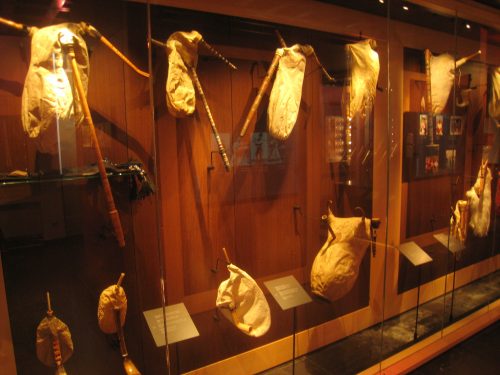
The Museum of musical instruments Belgium (MIM) is part of the Royal Department of Museums of Art and History and depends on the Belgian Federal Science Policy. Besides being a museum, the institution does educational work, research, concerts and public events.
The center participates in events such as the Night of the Museums Brussels, the Music Festival, the Summer Festival of Brussels and conferences on the World Heritage Belgium among others. It has a large world famous due to its extensive collection of over 7,000 musical instruments. These are well-tended and restored when necessary. For its delicacy, some are not for public view. MIM is part of the European project MIMO (Musical Instrument Museums Online) and Europeana. The museum’s website also makes choosing educational work, for example, the instrument of the month and showing the history of this and various information in pictures and videos.
Since 2000 MIM has become an important point in the cultural tourism of the city with an average of 125,000 visitors a year. Although the current organization of MIM dates from 1992, the center originated in 1877, when added to the Royal Conservatory of Music Brussels, with the didactic purpose of showing early instruments to students. The first collections of the museum belonged to the celebrated Belgian musicologist François-Joseph Fétis (1784-1871), acquired by the government in 1872, and the Rajah Sourindro Mohun Tagore (1840-1914), who offered to King Leopold II in 1876 and It is containing a hundred Indian musical instruments. Fétis was also the first director of the center.
These beginnings were already very good in itself, but the first curator, Victor-Charles Mahillon (1841-1924), expanded the collection by making it more important worldwide. At his death the MIM already had 3666 articles, of which 3177 were original instruments. Mahillon performed their work excellently and surpassing the expectations of everyone. In addition, between 1880 and 1922, the Conservative developed a five-volume catalog containing an essay that formed the basis for the subsequent work of EM von Hornbostel and C. Sachs which still is used to classify the instruments. Mahillon was also responsible for the creation in 1877 of the workshop where Franz de Vestibule restoring the instruments and made copies of copies of other public collections that could not be found at Brussels.
From 1880 concerts with ancient instruments or copies of them were organized. These were made by François-Auguste Gevaert, who succeeded Fétis in front of the Royal Conservatory of Music. Concerts, where they played teachers and students, became famous in Brussels and London in the late nineteenth century.
Mahillon increased collection of instruments through its connections with philanthropists, prominent scholars and diplomats in foreign countries. He also undertook to buy at auctions instruments to complete the collections he had in mind for the museum.
The pace of growth of the collections fell sharply after the death of Mahillon in 1924. Ernest Closson (1870-1950), his successor, wrote much about musical instruments, among other things by a monograph on the construction of musical instruments in Belgium who appear in the Universal Exhibition of Brussels in 1935. However, the number of craftsmen of musical instruments Belgium dropped dramatically in the 20s and 30s.
Roger Bragard (1903-1985), curator of the MIM between 1957 and 1968, managed to turn the tide back, drawing the attention of the Minister of Culture and Sara Huysmans and getting to be carried out reforms in the MIM and hired more personnel, among other measures. New pieces were acquired at that time by the MIM.
René de Maeyer Bragard took over between 1968 and 1989, hiring specialists in different fields of the organology. Nicolas Meeùs, in charge between 1989 and 1994, proposed the idea of moving the museum Old England building, which was conducted under the command of Malou Haine. Currently the person in charge is the Director General of the Royal Museums of Art and History, Eric Gubel.
Architecture
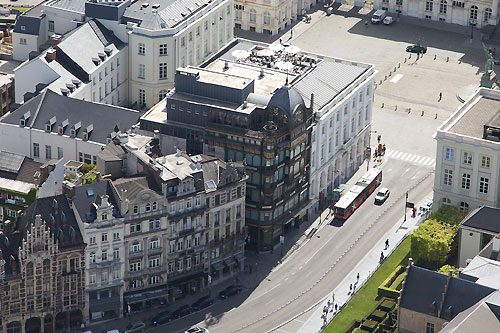
The original location of the collection, in 1877, was an annex of the Royal Conservatory of Music in the Rue aux Laines / Wolstraat. Later it moved to a building in the Rue de la Regence / Regentschapsstraat, designed by architect Jean-Pierre Cluysenaar. The center then took a small house on the corner of the Place du Petit Sablon / Kleine Zavel, which became the home of the director François-Auguste Gevaert (1828-1908). Due to the rapid growth of the collection, a new location had to be sought. Moreover, the conditions in which the instruments were stored were far from ideal, so when the situation became critical in 1926, Louis Cavens threatened to reclaim the items donated to the museum if the government did not take steps to improve situation. Were conducted workarounds and store Rue Aux Laines / Wolstraat expanded and the building of the corner of Place du Petit Sablon / Kleine Zavel became an exhibition space.
Arriving 1970s the collection was already divided into fifteen different buildings in the area of Sablon and Nord / Noord. It was at this time when the government realized that it had to reach a permanent solution to unify the whole museum. In 1978 the old buildings of the Old England stores to host both exhibitions were purchased files.
These two buildings are very different in style, one Neoclassical, which overlooks the Plaza Royale / Koningsplein and the other modernist, in Montagne de la Cour / Hofberg. The first part of the project for the entire block 1774 by the architect Barnabé Guimard, which was inspired by the Place Stanislas in Nancy. The second is one of the greatest exponents of modernism Brussels, built in 1899 by architect Paul Saintenoy. Besides these two buildings, a third was built in the Rue-Villa Hermosa-straat to accommodate more storage of collections.
The design of these buildings took several years, finishing the process in December 1998. The transfer of the collections made in 1999 and lasted ten months. The new MIM opened in June 2000.
Location
The Museum of Musical Instruments Belgium stands at number 2 Rue Montagne de la Cour de Brussels. The nearest train station is Gare de Bruxelles-Centrale, located about 200 meters. By public transport you can reach the center with lines 1 and 5 subway stop at the Gare Centrale or Parc, and the bus lines 27, 38, 71 and 95 stop off at the Royale. There is also a bicycle station right in front of the museum, the number 20.
Concept
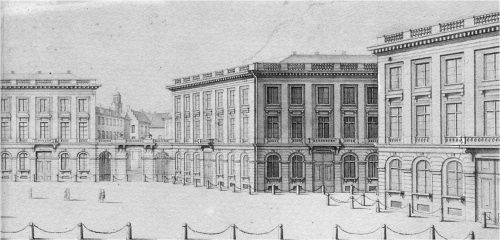
The MIM is part of all museums in the Mont des Arts, among which is also the Center Bozar. This is an area where the cultural centers of the Belgian capital are concentrated.
The current Museum of musical instruments Belgium is composed of two buildings. The oldest part of the set of real square. Neoclassical follows the trend of the time to set up a single image of an urban space through buildings and different architectures. So internal characteristics of each building are subordinated to the image of the city and creates is of the urban scene. The plaza is composed symmetrically ground while continuing the same pattern in different fronts, have a central point in the composition occupied by the Church of Saint-Jacques-sur-Coudenberg.
This ancient building of MIM, built in 1774, is the work of Barnabé Guimard (1731-1805) and Jean-Benoît-Vincent Barré. The Hôtel de Spangen was built at the initiative of the Austrian authorities at the time to replace the old Coudenberg Palace, burned down in 1731. This new palace was inspired by French models like Nancy Stanislas Square and the Royal Plaza de Reims. The project, approved in 1774 by Empress Maria Theresa of Austria, ended up being a monumental plan which involved several architects and needed funding guilds and nobles of the area. The building has had throughout its history many different uses, including: residence of Prince William of Orange, military court, Ministry of Public Works, Ministry of Railways, Court of Auditors, tour desk, hotel, part of the stores “Old England” and Musical Instrument Museum (MIM).
The modern building dates from 1899 and designed by architect Paul Saintenoy. He built it as an extension of the Old England stores, located in the Hôtel de Spangen. As a good example of Belgian modernism, the building, mainly iron, has large openings that allow the influx of light into the interior. It also shows typical motifs of this movement as floral details and sinuous shapes.
Spaces
The Museum of Musical Instruments Belgium is located in a beautiful complex of Brussels. This consists of a modernist building and other neoclassical. Between the two numbers 1,200 instruments in four galleries. The exhibition is accompanied by information panels, photographs and sounds.
Architecture
Spangen Palace
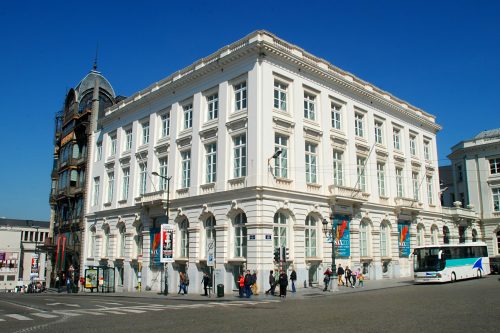
neoclassical building include its facade covered in white stone, a feature it shares with the other buildings of the Royal Plaza, many made by the same architect, due to a law of 1781 that defined the look this square He should have. It consists of three floors take on a classical composition, distributed on a ground floor basis, two floors and the building body, and as the crowning balustrade. The wall that adjoins the Art Nouveau building stretches to fit it. The interior of the building also retains its original neoclassical style that highlights the stone and parquet floors and walls and ceiling moldings.
Old England
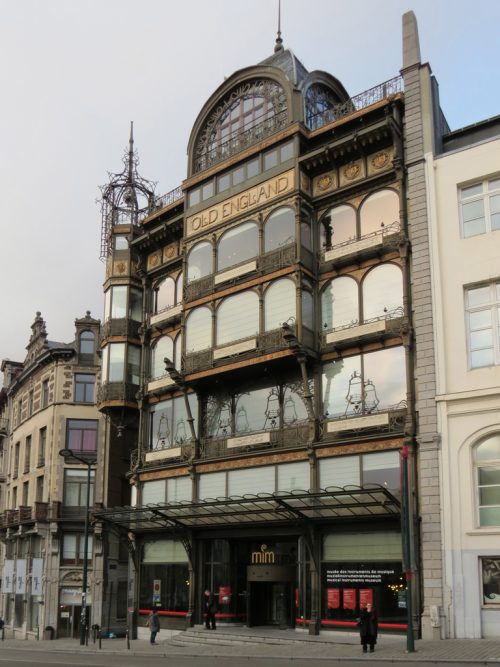
The first image that a visitor coming from the city center, is this building, accompanied by the neoclassical architecture of the Church of the Royal Plaza. Both contrast in style and tone. As you go down the sloping street can be increasingly appreciating the details of modernist architecture of this building. Of the six plants that comprise the low it is framed by a canopy that accompanies the gateway, and the latter is topped by a dome, where the on-site bar, and a decorative turret on the corner is located. Accompanying these are two volumes copings protruding from the ground of the facade. The most emblematic of this point is the sign “Old England”, name of department stores that originated this space. With him there are a number of shields that form a frieze. The entire set of rails and decorations are wrought iron facade, representing plant motifs. These are accompanied by friezes, faience plates with staves.
Program
The MIM has exhibition galleries, a concert hall, space for workshops (reservations required), a shop, a library and a restaurant with views over the city of Brussels. Since May 2015 the violin craftsman Thomas Meuwissen has established his workshop in the premises of MIM.
The galleries
In the 4th floor SAX200 was exhibited until early 2015. The gallery is under renovation and will reopen in 2016.
In the 2nd floor there are thematic exhibitions, organized chronologically, on Western classical music from the Middle Ages and the Renaissance to the late nineteenth century.
In the 1st floor is a room dedicated to traditional musical instruments. This is a favorite exhibition visitors. Start with Belgium and goes through all the European cultures and the world. A curiosity shown in this room is that apart from Scotland, many other nations have their own versions of the bagpipe. It also shows that Tibetans have musical instruments made from the bones of their dead comrades and African drums make the role of Twitter.
In the -1 floor is the exhibition “Musicus mechanicus” about the mechanical, electrical and electronic instruments. The star piece of this room is the componium an orchestral instrument nineteenth century composing an infinite variety of music automatically. This floor also is the collection of clocks and bells.
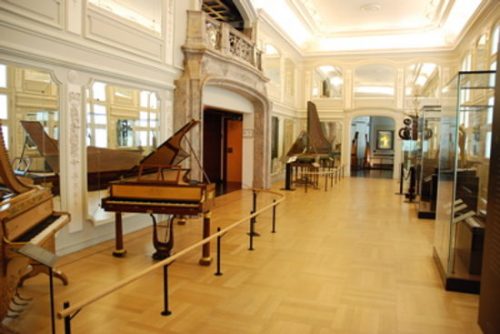
Collections:
- Western wind and percussion instruments (Géry Dumoulin).
- Western string instruments (Anne-Emmanuelle Ceulemans).
- Historic keyboards (Pascale Vandervellen).
- Electrical and electronic instruments (Wim Verhulst).
- Workshops and builders accessories (Géry Dumoulin, Anne-Emmanuelle Ceulemans).
- European traditional instruments (Wim Bosmans).
- Africa (Saskia Willaert).
- Middle East (Saskia Willaert).
- The Far East (Claire Chantrenne).
- India, Afghanistan and Pakistan (NN).
- Indonesia (NN).
- North and South America (NN).
- Oceania (NN).
The restaurant
The most spectacular point of the restaurant is the dome of Old England, Art Nouveau, from where you have magnificent views of the city from Brussels.
The concert hall
It is located on the 8th floor and has two hundred locations. It was built from scratch in the neoclassical part of the MIM. The atmosphere is quite intimate because the room has a similar arrangement of the Greek amphitheaters, distributed to the public in a semicircle around the artists. Not often needed any sound amplifier since the relationship between the artist, the instrument and the listener is so close. Most of the concerts offered in this space prints are for sale, educational atmosphere for different functions or exhibitions spaces. The MIM file already contains 400 music CDs. In addition, the MIM sells its own recordings in the museum shop. The concert hall can also be rented for events, meetings, conferences and private performances. This service can be combined with renting the restaurant. Concerts featuring MIM usually held in this room but sometimes take place in the exhibition galleries. A year are usually carried out about 130 musical events.
The store
Sells books, CDs, postcards and all kinds of musical gadgets. The store is always also by providing customers items that reflect the passion of the center by musical instruments and Art Nouveau. It also includes a children’s publications and educational nature.
Library
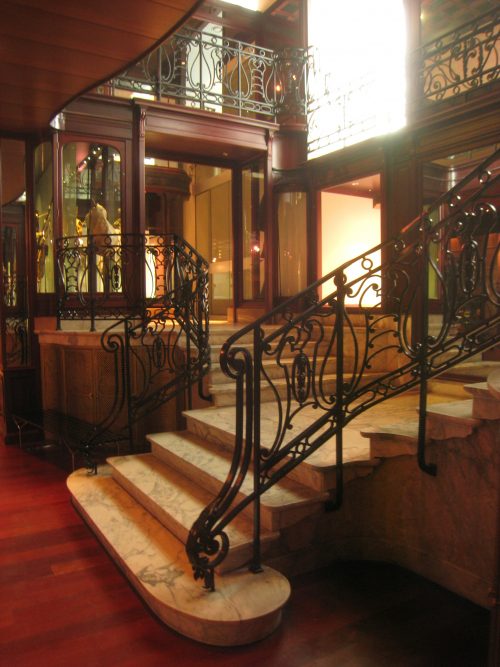
Its origins coincide with the center, founded in 1877. The library includes the scientific advances in the world of music and is continually expanding. The space is open to the public and is often used by researchers, musicologists, students, instrument builders, guides and employees of the MIM. The library also contain much information on organology (the study of musical instruments), includes information on Western, traditional, ethnic music and a variety of catalogs of exhibitions that the museum has taken place. Also has publications on musical performances and other art forms. Robert Pernet Foundation under the King Baudouin custom Foundation takes part of the library dedicated to Belgian jazz since 2004. The archives of the library, publications, books, magazines, newspapers and audiovisual material should be checked in the room. The material is available in several languages. The center also cataloged his collection and new acquisitions for exhibitions. The catalogs are available online: Carmentis, MIMO and Europeana.
Workshops and files
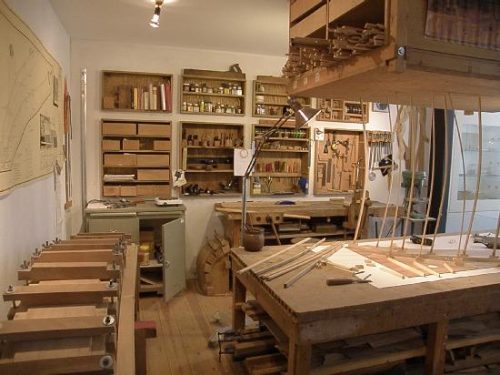
In this space by artisans that conserve and restore the instruments that have the museum. There are specialists working in wood, leather, copper and surface treatment. The workshop is only open its doors to other professionals working in the conservation of asking previously cited instruments. The restorers do a great job of historical research before getting down to work, unlike what was done formerly. The first center restorer, Franz of Vestibule, was dedicated around 1890 only to keep the instruments so they could touch and make copies of them, all under the supervision of the curator Victor Charles Mahillon (1841-1924). The MIM has some 1,200 instruments exposed but more than 5,000 files. They are kept clean and in a stable and perfect conditions of light, humidity and temperature for preservation.
Meuwissen Workshop
This is an instrument making workshop where the public can see live as they are created and can contact its creators.
The workshop
This space activities for groups of children but also adults carry. Here visitors can play instruments and contact materials, sounds and vibrations. The space is divided into several zones for different types of instruments.
Structure and Materials
The neoclassical structure is bearing walls, while modernist building consists of thin concrete slabs, eight cm thick, supported on slender columns of iron.
The materials used in the building Barnabé Guimard are masonry and stone on the outside and plaster for moldings, and names woods for flooring, inside. The predominant materials in the building of Paul Saintenoy are the wrought iron, cast iron and glass. In addition there are friezes facade and inside earthenware floor tiles and marble.











































































































